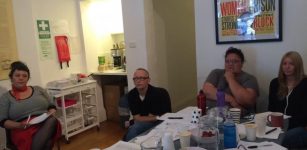Supporting Criminalised Women: An Interview with Flat Out’s Jake Argyll

The Australian prison population is at an all-time high.
At the end of June last year, there were 38,845 adult prisoners in Australian correctional facilities. Women accounted for 3,094 of them, which is 8 percent of the overall adult prison population.
But what a lot of people in the community don’t realise is that, right now, there are more women behind bars in Australia than ever before.
In 1982, the female imprisonment rate was 6.9 inmates per 100,000 adult women, while in 2015 it had reached 30.8 per 100,000 women. This is a 4.5-fold increase in the imprisonment rate of women.
Women in Victorian correctional facilities
In June last year, there were 461 adult women prisoners in Victorian correctional facilities.
Between June 2006 and June 2016, the Victorian female prison population increased by 75 percent, up from 245 adult women to 428. Over that same period, the female prison population grew at a 45 percent greater rate, than the male prison population did.
There’s also been a rise in the rate of Victorian women prisoners on remand – those women who have been refused bail, and are languishing in prison waiting for the finalisation of their cases.
In May 2015, 36 percent of female prisoners in the state of Victoria were remandees. And of these women, a whopping 60 percent were later released by the courts.
This means the women that were released had their lives on the outside disrupted for offences that they didn’t commit or didn’t end up serving a prison sentence for.
Investing in incarceration
In May 2015, the Victorian government announced it was investing $119 million over a four year period into expanding the women’s prison system.
At the time, the government’s budget documents forecast that the female prisoner population was set to increase by 35 percent – or 158 extra beds – over the following two years.
Three new accommodation units were completed at Victoria’s only maximum-security prison for women in December last year, which is leading to an additional 120 beds at the Dame Phyllis Frost Centre.
Investing in brighter futures
Flat Out is a Victoria-wide support and advocacy service for women who come into contact with the criminal justice system and/or the prison system. They receive their funding from the Victorian and federal health departments, as well as via grassroots fundraising.
Established in 1988, the independent non-profit has an outreach support and advocacy team that visits women out in their communities. Flat Out has also been a vocal part of the prison abolition movement, both in Australia and internationally.
Jake Argyll is the executive officer of Flat Out. Prior to her current role, Argyll had been working for various homelessness services. Sydney Criminal Lawyers® spoke with Jake about the housing crisis for women leaving prison, the lack of health services on the inside and the rise in women prisoners on remand.
Firstly, Jake, there’s been a huge increase in the rate of women being imprisoned in Victoria over the last decade.
In your opinion, what’s led to such a rapid increase in these numbers?
There’s a number of reasons. In Victoria, there’s the changes to sentencing, bail and parole. There’s also been less leniency from the courts.
There’s been the media perception – “the law and order” hype around people who commit crimes being dangerous. In actual fact, most of the women who are imprisoned are put in prison for non-violent crimes.
And often, it’s for victimless crimes related to their own drug use or drug possession. There’s a lot of women in prison for traffic fines that they can’t afford to pay. Poverty is the driver in the end.
In Melbourne, there’s a tendency for women to be remanded more when they’re homeless, simply because of the lack of housing available for women.
Flat Out provides support services for women who are released from prison. One of the major challenges these women face is finding housing.
At the moment, just how difficult is it for women leaving prison in Victoria to find adequate housing? And what sort of outcomes is this leading to?
Statistically women are more likely to return to prison within three to six months if they don’t have housing upon release.
They’re more likely to return to dangerous or unhealthy relationships if they’re released without a housing option in place.
There’s a chronic lack of housing available for all homeless people in Melbourne. And being released from prison without housing is pretty typical really, because there’s a difficulty accessing housing in a timely fashion.
Women might end up going into caravan parks or motels or dodgy private rooming houses. If that’s the case, the tendency is that they’ll more than likely end up going back to prison.
Flat Out also works towards keeping women out of prison once they’ve been released.
How likely are these women to find themselves back in prison? And how does your organisation work to prevent them reoffending?
Women tend to reoffend when they’re broke or homeless, and they’re at risk.
When they haven’t got support, they’re more likely to offend mostly around crimes of need, not crimes of want. So shoplifting more, or traveling without trams tickets. That sort of thing.
Unfortunately, being homeless puts women more at risk anyway, as they’re being seen and easily identified by police, because they’re out there in the public. They’ve got nowhere to go. And they’ve got no place to sleep, so they’re easily identified out there in the world.
How we work with women is we provide support and we link them in. We have outreach support. We’re really proactive, and have an assertive outreach model, where we go to where the women are.
We work closely with them. We link them into health, legal services, mental health, and drug and alcohol programs. Whatever it is that they need to address the issues that put them at risk of being re-incarcerated.
We take the approach that if you provide safe and supportive services for women, the chances are, they’re less likely to be in a position where they’re incarcerated.
Your organisation is also working towards improving the rights and conditions of women whilst in prison.
What are some of the deprivations and injustices that women on the inside are facing?
A lack of consistent or easily accessible healthcare is a big issue. From all the anecdotal evidence and information we hear from women we’ve worked with is that they have difficulties accessing health and medical support in prison – accessing that in a timely fashion.
And there’s also difficulty in health and medical support plans following them when they’re release from prison.
I heard from a doctor recently, where she had a woman come to the hospital to her clinic, who was supposed to have surgery. But because the prison couldn’t transport her there she missed that surgery.
They rescheduled the surgery – which was for cancer – but the woman didn’t turn up.
The hospital rang the prison and said, “Where is she?” And they said, “She was released. And we can’t tell you where she is.” And yet this woman was walking around with a serious issue that no one’s told her about.
This is incompatible with human rights. And incompatible with supportive healthcare for women. It just puts them more at risk.
Currently, in Victoria close to 40 percent of women in prison are actually on remand.
What is it about the Victorian criminal justice system that’s leading to an increasing amount of women being placed behind bars that haven’t actually had their cases finalised?
I’ve been part of a discussion about this recently. And what we’re finding is that women are generally moved to remand when the magistrate thinks they’re at risk.
At risk of harm, or at risk of offending. At risk of continuing to use a substance or alcohol in a way that might make them reoffend. They’re also subject to being put on remand when they don’t have accommodation, and they don’t have access to immediate or adequate support.
So due to the lack of housing women are being put on remand because they’ve got nowhere else to stay in the meantime?
That’s certainly one part of it.
A woman would much rather go to detox or rehab, than go to remand, because when you’re on remand you don’t get access to anything. You don’t get any support.
That goes back to that discussion before about deprivations. When you’re on remand you get no services.
What sort of issues does having such a large prison population on remand lead to?
There’s obviously the issue of where do you put all these women. How many beds have you got? And how many can you possibly safely house in a prison unit.
The other thing is transport – transporting women to court in a timely fashion.
Don’t forget too that some women are spending time in police cells. That not always the best option for them. Then from police cells, they’re usually shifted off to remand.
But again, if they can’t get to court, then their cases are delayed, because there’s no transportation and there’s nowhere safe for the women to be held at the court, while they’re waiting for their cases to come up.
They’ve also got to have access to a lawyer that will challenge the remand and apply for bail. There’s suggestions that sometimes women aren’t even asked whether they want to apply for bail. They’re just remanded.
Certainly, that’s a lack of care on the representative side. And it also speaks to the lack of resources available to legal representatives to adequately represent the women who are in the caseload.
Indigenous women account for the largest growth in prison population nationally.
Why is there such a large growth in Aboriginal and Torres Strait Islander women being incarcerated in this country? And what sort of issues do Indigenous women who come into contact with the criminal justice system face?
Society in general is inherently racist towards First Nations peoples. And definitely, very racist towards Aboriginal women. Their contact with the justice system is driven a lot by, again, poverty and disadvantage. And there’s a lack of safe spaces for Aboriginal women to escape family violence.
There’s a lack of appropriate housing for them in the communities, where they prefer to live – where their connections are. And again, being homeless makes anyone at risk of criminalisation, simply because you’re not safely in your home, away from the eyes of police.
If you’re out on the streets – and for whatever behaviour somebody deems to be inappropriate – you can be picked up for that, just simply by virtue of being more exposed to police.
So homelessness is an horrific problem for Aboriginal people. They’re the smallest cultural population, and they’ve got the highest rate of homelessness. That’s just crazy.
And lastly, Jake, Flat Out has always advocated for prison abolition. Your organisation believes that prisons will eventually be abolished and they’ll be viewed as an antiquated institution in the same way slavery is today.
In your opinion, just how much of an impact has the prison abolition movement had over recent decades?
If you look at the US, where they’re actually shutting down prisons, it looks to me like it’s having an impact.
The realisation is – and there’s reams of data out there that suggests this – prisons are counterproductive. They don’t actually solve any of the social problems that they suggest they do.
All this money getting pumped into more prisons isn’t going to solve the issues that people have been imprisoned for.
And if you lock people up and you don’t give them access to healthcare, mental health support and education, then all you’re doing is holding that problem off again.
Then they’re released back out into the community, where they’ve still got nothing, and are more than likely to go on to reoffend, and be sent back in again.
There’s a growing movement that understands that prisons are not a productive, useful or healthy space for people.
Jake, thanks for taking the time out to have this chat with us. And continued success with the work Flat Out is undertaking in supporting criminalised women in Victoria.
Yeah well, we’re powering on: bigger and better, stronger and harder.
Receive all of our articles weekly
Author

Paul Gregoire






